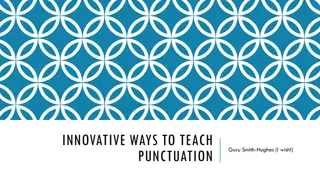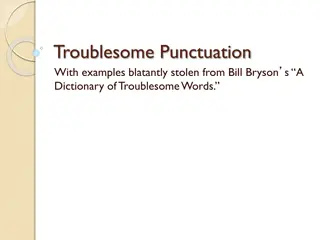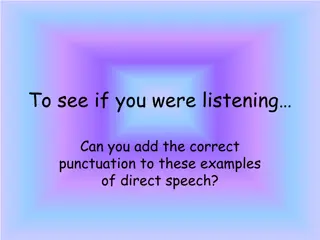Importance of Punctuation Marks in Writing
Learn about the significance of using punctuation marks such as periods, commas, question marks, exclamation points, colons, semi-colons, slashes, dashes, parentheses, brackets, quotation marks, and ellipsis. Discover the roles these punctuation marks play in structuring sentences, conveying meaning, and enhancing the overall clarity of written communication.
Download Presentation

Please find below an Image/Link to download the presentation.
The content on the website is provided AS IS for your information and personal use only. It may not be sold, licensed, or shared on other websites without obtaining consent from the author. Download presentation by click this link. If you encounter any issues during the download, it is possible that the publisher has removed the file from their server.
E N D
Presentation Transcript
PUNCTUATION PUNCTUATION Learn about the importance of using punctuation like: Periods Commas Question Marks Exclamation Points Colons Semi-colons Slash Dashes Hyphens Parentheses Brackets Quotation Marks Ellipsis
Slash Slash Slashes are used for the following reasons: To separate a word when both words apply. Example: Every soldier should stay vigilant during his/her post. Tip: you can always replace words like his/her with their. To show line breaks when quoting poetry. Example: Langston Hughes s poem read in part, Hold fast to dreams/For if dreams die/Life is a broken-winged bird/That cannot fly.
PERIOD PERIOD According to the Merriam-Webster Dictionary, a period is defined as a punctuation mark used to mark the end of a declarative sentence. Periods are used in everyday writing to end statements, mild commands or requests, and indirect questions. Example: 1. Something is rotten in Denmark. (statement) 2. When the bell rings, please be sure to leave in an orderly fashion. (request) 3. They wondered whether the water was safe to drink. (indirect question) They are also used to end abbreviations, mark divisions in dramatic, poetic, and biblical references, and mark divisions is electronic addresses. Example: 1. Hamlet 2.2.1-5 (dramatic reference) 2. Judges 4.14 (biblical reference)
COMMAS COMMAS A comma is simply defined as a punctuation mark used especially to mark a separation within a sentence. Truthfully, commas have many functions. You use a comma when forming a compound sentence by linking two independent clauses with a coordinating conjunction. Example: 1. The house approved the bill, but the Sente rejected it. 2. Either the hard drive is full, or the modem is too slow. You also use commas to separate three or more coordinate elements Example: 1. Chipmunk, raccoon, and Mugwump are Native American words. *Do not use a comma to introduce or to close a series
Use commas to set off parenthetical expressions. (A parenthetical expression is one that is used to extend the meaning of a word or phrase but is not one of the main parts of the sentence. The sentence makes sense without the parenthetical). Example: 1. You are, I hope, planning to attend the session. 2. Dylan s new poems, in fact, are not inspiring. COMMAS Use commas between items in a series of two or more coordinate adjectives adjectives that modify the same word/word group unless they re joined by a conjunction. Example: 1. She brushed her long, shining hair. 2. The baby was tired and cranky and wet. (adjectives joined by conjunctions; no commas required) Introductory dependent clauses and verbal phrases are generally set off from the rest of the sentence using a comma. Example: 1. When war came to Baghdad, many victims were children. (introductory dependent clause) 2. To write well, one must read a lot. (introductory verbal phrase)
COMMAS When a sentence is started by a transitional word phrase, It is usually separated by a comma. Example: 1. However, any plan that is enacted must be fair. 2. In other words, we cannot act hasty. Use commas to set off nonrestrictive modifiers, which supply nonessential information to a word or a word group in a sentence. Do not use commas to set off restrictive modifiers Example: 1. Actors, who have inflated egos, are often insecure. All actors are insecure (nonrestrictive, comma needed) 2. Actors who have inflated egos are often insecure. Only actors with inflated egos are insecure (restrictive, comma not needed)
Commas, FANBOYS Use commas and a coordinating conjunction with a compound sentence. A compound sentence is two complete sentences connected by a coordinating conjunction. Coordinating conjunctions are also known as FANBOYS words. ,FOR I was eager to go, for I was prepared. ,AND Buster wanted to go, and he is very prepared for the task. ,NOR He didn t talk to his friends, nor did he call his wife. ,BUT I work on Friday, but I don t have to work on Saturday. ,OR He must study hard for the exams, or he will fail. ,YET I ran very fast, yet I came in last. ,SO My sister is very sweet, so everybody likes her.
Question Question Marks Marks Question marks are used to mark the end of a direct question. Example: 1. Who was that man at the door? 2. Is this a silver bullet? they asked. Tip: If a title contains a question mark, always place it within quotation marks. However, if the title does not ask a question, place the mark outside of the quotation marks. 1. Did you read Can we Defeat Hunger? in Newsweek yesterday? 2. Have you ever read Poe s The Raven ?
Exclamation Points 1. 2. 3.
Colons Colons set off lists or series, including those introduced by phrases. They are also used to introduce materials that explain, exemplify, and summarize. Example: 1. Waiting tables requires three skills: memory, speed, and balance. (list or series) 2. She had one dream: to play professional basketball. (explanatory material) Colons can also be used to separate items into numerals, ratios, titles, and time references. 1. Example (ratios): The FSU football team has a 3:1 advantage over the opposing team. 2. Example (titles): I just finished reading Borderlands La Frontera: The New Mestiza. 3. Example (time): The movie starts at 2:30 pm.
Semicolons warn the reader to pause a little longer than for a comma, but not as long as a period. It is only used between two items of equal grammatical rank: two independent clauses, two phrases, etc. It could be called a soft period. Semi-Colons Example: 1. Paul Revere s The Boston Massacre is traditional American protest art; Edward Hick s paintings are socially conscious art with a religious strain. 2. Thomas Jefferson brought two hundred vanilla beans and a recipe for vanilla ice cream back from France; thus, he gave America its all-time favorite ice cream flavor. Semicolons are also used when: Separating items in a series that already contains commas. Example: 1. The governor will meet with Tyla Moore, the mayor; Haleigh Thomas, the new city manager; and Tre Carlson, the district attorney. To join independent clauses when words like and, or, yet, but, for, nor, or so (FANBOYS) are not present. Example: 1. Raleigh is the capital of North Carolina; Columbia is the capital of South Carolina.
Apostrophe o Tip: Apostrophes may or may not appear in possessive names of businesses or organizations. For example, Denny s and Tigers Stadium o o Example: I got all A s this semester. Example: My shoe size ranges between 7 s and 8 s. Example: All of the 2009 s were sold on the lot.
DASH Dashes are used to set off nonessential material. Unlike commas, dashes Dashes are used to set off nonessential material. Unlike commas, dashes call attention to the material that they set off. Dashes are also used to call attention to the material that they set off. Dashes are also used to introduce a statement that summarizes a list or series and can mark introduce a statement that summarizes a list or series and can mark hesitation or an unfinished thought. For emphasis, you may use dashes hesitation or an unfinished thought. For emphasis, you may use dashes to set off explanations, qualifications, examples, definitions, and to set off explanations, qualifications, examples, definitions, and appositives. appositives. Example: 1. Neither of the boys both nine years old had and history of violence. 2. Study hard, Respect your elders, Don t talk with your mouth full Sharon had often heard her parents say these things. 3. I think no, I know this is the worst day of my life, Julie sighed.
HYPHEN A hyphen is used to divide a word at the end of a line and connect words to indicate that they have a combined meaning. Example: Ice-cream, 9-year-old Hyphens can also be used to: Break words at the end of a line. Example: I say Janet on the tele- vision last night. When using certain prefixes or suffixes. Example: You shouldn t self-diagnosis as you could do a lot of damage to your body. Divide a word that is already hyphenated only at the hyphen. Example: self-defense, happy-go-lucky Between combinations of words and numbers. Example: That is a 2.5-ton truck. Do NOT hyphenate a proper name or separate a title, initials, or first name from the surname. Note: Dashes are longer than hyphens. Make sure to not get the two confused.
Use parentheses to enclose material that expands, clarifies, illustrates, or supplements. Parentheses Example: In some European countries (notable Sweden and France), high-quality daycare is offered at little or no cost to parents. Parenthesis is also used in writing when making in-text citations. Example: It is very nearly impossible to become an educated person in a country so distrustful of the independent mind (Baldwin 96). Parenthesis can be used when enclosing letters and numbers. Example: The Federal Bureau of Investigation (FBI) has just released a statement about new security policies. Example: My recommendation is that we must (1) provide improved student services, (2) improve campus accessibility, and (3) increase funding.
Brackets Brackets are used for the following reasons: oTo set off corrections or add clarification in quotes. oTo replace something in a quotation for clarity. oExample: You can t take it [your possessions] with you.
QUOTATION MARKS Use quotation marks to set off directly quoted speech or writing, certain titles, Use quotation marks to set off directly quoted speech or writing, certain titles, and words used in special ways. Quotation marks are used mainly to show the and words used in special ways. Quotation marks are used mainly to show the reader that someone s EXACT WORDS are being reproduced reader that someone s EXACT WORDS are being reproduced quotation marks come in pairs; one at the beginning of the quote, and one at the quotation marks come in pairs; one at the beginning of the quote, and one at the end. end. therefore, therefore, Example: 1. Gloria Steinem said, We are becoming the men we once hoped to marry. - A direct quotation begins with a capital letter. Other marks of punctuation, used with quotation marks, are placed according to these rules: A. Commas and periods are always placed INSIDE the closing quotation marks. B. Other punctuation marks (!,?) are placed inside the closing quotation marks if the quote is posing a question or exclamation. C. Colons and semicolons (; :) are placed OUTSIDE the closing quotation marks unless they are part of the quote. D. You can use quotation marks to add emphasis. Example: That joke James told was uncalled for. E. Use quotation marks to enclose the titles of short works (i.e. poems, songs, episodes, short stories, or articles). Example: Did you watch the episode The Block is Hot from The Boondocks?
Ellipsis Use ellipsis when you are indicating that words are deleted from quoted material. Example (original): The mayor said, Our city, which is the country s most progressive, deserves a high- tech light-rail system. Example (with ellipsis): The mayor said, Our city deserves a high-tech light-rail system. Tip: Only omit minor details as long as they will not change the basic meaning of a sentence. Never omit negative words like not to create a positive meaning. Tip: When deleting words at the end of a sentence, add a period before the ellipsis. For example, The governor said, We need a new rail system . Tip: Never use an ellipsis if you are deleting words at the opening of a quotation. For example, The mayor said that the city deserves a high-tech light-rail system. Tip: if deleting words creates a grammatical mistake, then insert brackets with the correction. Original: Poe, Emerson, and Whiteman were among our greatest writers. With Ellipsis: Poe [was] among our greatest writers.
References Connelly, Mark. (2014) Get Writing: Sentences & Paragraphs. 3rd ed., Wadsworth. Kirszner, L., & Mandell, S. (2007). The Concise Wadsworth Handbook: Second Edition. Cengage Learning. Mish, F. C. (2003)The Merriam-Webster Dictionary: 11th Edition. Merriam-Webster Inc.























